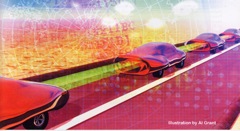 Catherine G. Burke, an associate professor at USC’s School of Policy, Planning and Development, had an article published in today’s LA Times touting the benefits of the podcar system for replacing cars and roads:
Catherine G. Burke, an associate professor at USC’s School of Policy, Planning and Development, had an article published in today’s LA Times touting the benefits of the podcar system for replacing cars and roads:
We will need something better than the auto — and better is here, now. It’s a “podcar,” also called “personal rapid transit” — a system of vehicles that provide on-demand, private, nonstop travel. These vehicles can carry people or light freight. They ride on small, overhead guideways — like a monorail or people mover — above existing roads, and are powered entirely by electricity. Picture the car as an elevated, driverless taxi. It’s under computer control, so there would be no accidents, thereby saving lives and lowering insurance costs. Podcars operate on demand, waiting at off-line stations; they can be summoned if one is not available when you arrive at the station. Each vehicle can hold four people, yet the system can be cost-effective even with a single rider for each trip.
Not bad. But I’ve got to share these things with other people who used them before me. I must wait for them to arrive at times. I can’t choose which podcar I want in particular, with the features I like. And I’m screwed for transport once I leave the podcar system. It sounds like riding the subway to me. No, I don’t like this idea. I’ve got something better.
The car.
The car is brilliant! Yours is your own: if there’s a mess in it, you put it there, not some of multitudes of strangers whom you must share it with. It’s always there for you where you left it, like a loyal steed. No waiting, unless you parked valet. You can choose the exact feature set, style, entertainment system, quality and comfort level that suits you. And it can go anywhere, including all the way home to your garage.
But there are problems with cars that the podcar would solve, isn’t that so? Accidents, congestion, and the fact that many of our freeways are already beyond their maximum volume capacity with no more room for growth.
Enter the Automated Highway System. It’s cheaper than the podcar system to set up, can be done quicker and would utilize our existing highway surfaces without the need to build anew. What’s more, we already have virtually all of the technology we’d need to do it. Picture this: you go into your garage, get into your (electric or hydrogen-powered?) car, turn it on and choose your destination. You drive yourself through city streets until you reach the AHS. As you approach the on-ramp, you hear a tone indicating that you are about to join the AHS. You take your hands off the wheel and the autonomous cruise control takes effect. You feel a surge of speed as the car accelerates safely to maybe 150mph as it joins the other traffic, following only a few yards behind the car in front. Using sensors on the vehicle, networking and magnetized markers on the road surface, the onboard computer is communicating with the other vehicles on the road as they coordinate themselves into tight platoons of eight to twenty-five cars, minimizing air resistance, improving fuel efficiency and ensuring that a vast volume of traffic is able to fit into the road space. Your commute time is fast, reliable and effortless. As you approach your exit, your car leaves the platoon into the enter/exit lane and then out of the AHS completely, at which point you can resume driving if you like.
Sound far-fetched? Well it’s certainly less so than the podcar system, which requires us all to use a new kind of carriage on an entirely new network of monorail. And it’s already been tested with great success:
The PATH project, a prototype automated highway system, was tested in San Diego County, California in 1991 along Interstate 15. … The AHS system places sensory technology in cars that can read passive road markings, and use radar and inter-car communications to make the cars organize themselves without the intervention of drivers. Such an autonomous cruise control system is being developed by Mercedes-Benz, BMW, Volkswagen and Toyota.
Who wants a podcar? We’re done waiting for public transportation. The future is in making our existing automobiles capable of high-speed, congestion-free, emissions-free, hands-free travel. Now that’s a solution.

